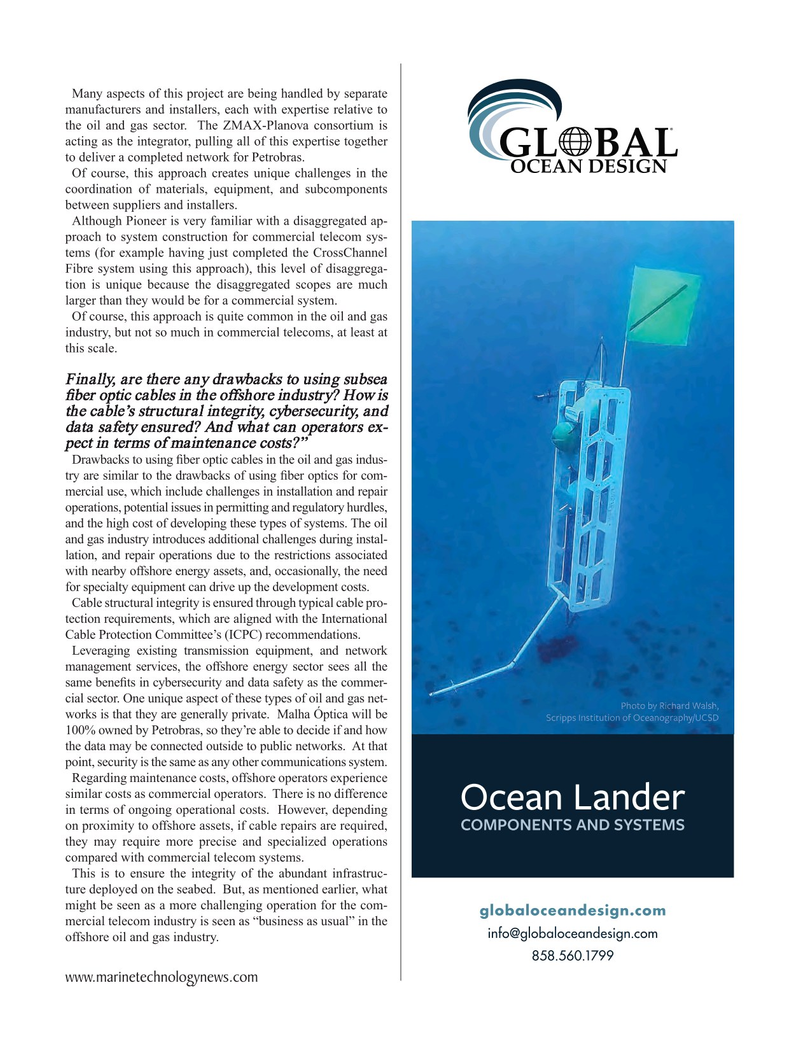
Page 43: of Marine Technology Magazine (May 2023)
Read this page in Pdf, Flash or Html5 edition of May 2023 Marine Technology Magazine
Many aspects of this project are being handled by separate manufacturers and installers, each with expertise relative to the oil and gas sector. The ZMAX-Planova consortium is acting as the integrator, pulling all of this expertise together to deliver a completed network for Petrobras.
Of course, this approach creates unique challenges in the coordination of materials, equipment, and subcomponents between suppliers and installers.
Although Pioneer is very familiar with a disaggregated ap- proach to system construction for commercial telecom sys- tems (for example having just completed the CrossChannel
Fibre system using this approach), this level of disaggrega- tion is unique because the disaggregated scopes are much larger than they would be for a commercial system.
Of course, this approach is quite common in the oil and gas industry, but not so much in commercial telecoms, at least at this scale.
Finally, are there any drawbacks to using subsea ? ber optic cables in the offshore industry? How is the cable’s structural integrity, cybersecurity, and data safety ensured? And what can operators ex- pect in terms of maintenance costs?”
Drawbacks to using ? ber optic cables in the oil and gas indus- try are similar to the drawbacks of using ? ber optics for com- mercial use, which include challenges in installation and repair operations, potential issues in permitting and regulatory hurdles, and the high cost of developing these types of systems. The oil and gas industry introduces additional challenges during instal- lation, and repair operations due to the restrictions associated with nearby offshore energy assets, and, occasionally, the need for specialty equipment can drive up the development costs.
Cable structural integrity is ensured through typical cable pro- tection requirements, which are aligned with the International
Cable Protection Committee’s (ICPC) recommendations.
Leveraging existing transmission equipment, and network management services, the offshore energy sector sees all the same bene? ts in cybersecurity and data safety as the commer- cial sector. One unique aspect of these types of oil and gas net- hardW als by Richard Wals by by P to by R Richard Wals Pho Photo by Richard Wals P Photo o o t by y Ric ic ic ichar a h h h h d Wals lsh, h, h, h h, h, h hardW alsh, works is that they are generally private. Malha Óptica will be hy/UCS hy/UCS fO ce c nog fO cea o raphy/UCS itu itution f Oceanog nstitutiono fO ceanography/UCS S ipp nstitution of Ocean nography/UCS Scr S Scripps I s I s s nst st stitu tu utio i ion o o o of Oceanogr rap phy/ y hy/UCS SD D D D D D DUCSD 100% owned by Petrobras, so they’re able to decide if and how the data may be connected outside to public networks. At that point, security is the same as any other communications system.
Regarding maintenance costs, offshore operators experience similar costs as commercial operators. There is no difference
Ocean Lander in terms of ongoing operational costs. However, depending on proximity to offshore assets, if cable repairs are required,
COMPONENTS AND SYSTEMS they may require more precise and specialized operations compared with commercial telecom systems.
This is to ensure the integrity of the abundant infrastruc- ture deployed on the seabed. But, as mentioned earlier, what might be seen as a more challenging operation for the com- globaloceandesign.com mercial telecom industry is seen as “business as usual” in the [email protected] offshore oil and gas industry. 858.560.1799 www.marinetechnologynews.com
MTR #4 (34-47).indd 43 6/1/2023 9:23:23 AM

 42
42

 44
44
